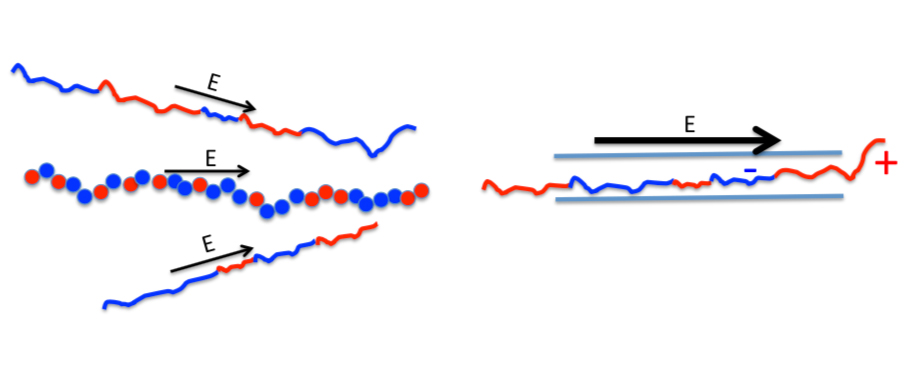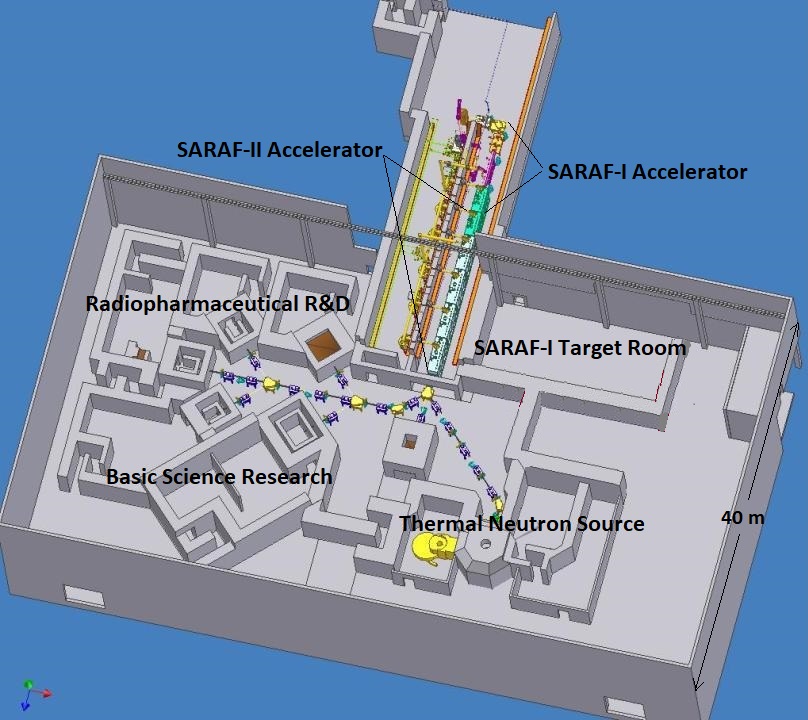News
EPJ E Highlight - Electrical disorder acts like a traffic light for a biological gate
- Details
- Published on 26 June 2018

New study of how positive and negative electrical charge disorder at the ends of polymers acts like a green or red light for proteins to pass through biological membranes
Nature’s way of allowing proteins across its gates, through porous biological membranes, depends, among others, on their electrical charge. For a protein to cross this type of membrane, it needs to be stimulated by an electrical field. A new study focuses on a particular kind of proteins that have multiple functions - dubbed Intrinsically Disordered Proteins - because the electric charge disorder on their surface makes it possible for them to take multiple shapes. In the work, recently published in EPJ E, Albert Johner from the Charles Sadron Institute (part of the CNRS) in Strasbourg, France and Jean-Francois Joanny from Paris reveal how the mixed electrical charge at the ends of the proteins influences biological membrane crossing. This has potential implications for our understanding of how proteins travel across the body, and of disease mechanisms.
EPJ B Highlight - Futuristic data storage based on controlling the interactions between nanodots magnetic ‘mood’ twirls
- Details
- Published on 18 June 2018

Better understanding of the changing magnetic state of nanometric squares in an array could be the basis for future ultrahigh density data storage
The magnetisation of nanometric square material is not fixed. It moves around in a helical motion. This is caused by the electron whose degree of freedom, referred to as spin, which follows a precession motion centred on the middle of a square nano-magnet. To study the magnetisation of such material, physicists can rely on two-dimensional arrays of square nanomagnets. In a paper published in EPJ B, P. Kim from the Kirensky Institute of Physics, associated with the Russian Academy of Sciences, in Krasnoyarsk, Siberia, Russia, and colleagues have devised a new model taking into account the factors affecting the magnetic interaction between individual nanomagnets. Better controlling such nanomagnets arrays could have applications in ultrahigh density data storage,in an electronic application called spintronics exploiting electron spins and its magnetism, and in micro- and nanosurgery controlled by magnets.
EPJ Plus Highlight - Rush hour metro crowd governed by people’s eagerness to go home
- Details
- Published on 14 June 2018

New model examines the relative role of random interactions between individuals in a crowd compared to interactions stemming from their eagerness to be on their way
Ever found yourself crushed in a metro station at rush hour? The mathematician Carlo Bianca and physicist Caterina Mogno, both from the engineering research lab ECAM-EPMI in Cergy-Pontoise, France, have developed a new model to study the movement of crowds exiting a metro station. In a recent study published in EPJ Plus, they have for the first time employed models typically used to study gases consisting of a large number of molecules that collide at random (known as thermostatted kinetic theory) to study the consequences of the different interactions occurring among pedestrians in a crowd while exiting a metro station.
EPJ D Highlight - When photons spice up the energy levels of quantum particles
- Details
- Published on 12 June 2018

New study reveals theoretical calculation of new possible state for quantum particles which have received a photon
Quantum particles behave in mysterious ways. They are governed by laws of physics designed to reflect what is happening at smaller scales through quantum mechanics. Quantum state properties are generally very different to those of classical states. However, particles finding themselves in a coherent state are in a kind of quantum state which behaves like a classical state. Since their introduction by Erwin Schrödinger in 1926, coherent states of particles have found many applications in mathematical physics and quantum optics.
Now, for the first time, a team of mathematical physicists from Togo and Benin, call upon supersymmetry - a sub-discipline of quantum mechanics - to explain the behaviour of particles that have received a photon. These particles are subjected to particular potential energies known as shape-invariant potentials.
In a paper published in EPJ D, Komi Sodoga and colleagues affiliated with both the University of Lomé, Togo, and the University of Abomey-Calavi, in Cotonou, Benin, outline the details of their theory. These findings are relevant to scientists working on solving quantum optics and quantum mechanics applications.
EPJ A Highlight - The Soreq Applied Research Accelerator Facility (SARAF)
- Details
- Published on 12 June 2018

The Soreq Applied Research Accelerator Facility (SARAF) is under construction in the Soreq Nuclear Research Center at Yavne, Israel. Phase I of SARAF (SARAF-I) is already in operation, generating scientific results in several fields of interest, especially the astrophysical s-process. When completed at the beginning of the next decade, SARAF-II will be a user facility for basic and applied nuclear physics, based on a 40 MeV, 5 mA CW proton/deuteron superconducting linear accelerator. This review presents first a technical overview of SARAF-I and II, including a description of the accelerator and its irradiation targets, and provides a survey of existing research programs at SARAF-I. It then describes in some detail the research potential at the completed facility. SARAF-II’s cutting-edge specifications, with its unique liquid lithium target technology, will enable world-competitive research plans in several disciplines: precision studies of beyond-Standard-Model effects by trapping light exotic radioisotopes (including meaningful studies already at SARAF-I); extended nuclear astrophysics research with higher-energy neutrons, including generation and studies of exotic neutron-rich isotopes relevant to the astrophysical r-process; nuclear structure of exotic isotopes; high-energy neutron cross sections for basic nuclear physics and material science research, including neutron-induced radiation damage; neutron-based imaging with an imaging plane flux similar to that of a 5 MW research reactor; accelerator-based neutron therapy; and, last but not least, novel radiopharmaceuticals development and production.
EPJ B Colloquium - Laser and hot-electrons induced ultrafast magnetic phenomena in multilayers and nanostructures
- Details
- Published on 04 June 2018

Understanding and controlling the magnetization dynamics in magnetic multilayers and nanostructures on the femtosecond timescale is becoming indispensable, both at the fundamental level and to develop future technological applications. While direct laser excitation of a ferromagnetic layer was commonly used during the past twenty years, laser-induced hot-electrons femtosecond pulses and subsequent transport in magnetic multilayers have attracted a lot of attention. Indeed, replacing photons by hot-electrons offers complementary information to improve our understanding of ultrafast magnetization dynamics and to provide new possibilities for manipulating the magnetization in a thin layer on the femtosecond timescale.
EPJ B Highlight - Unzipping graphene nanotubes into nanoribbons
- Details
- Published on 30 May 2018

New study shows elegant mathematical solution to understand how the flow of electrons changes when carbon nanotubes turn into zigzag nanoribbons
In a new study published in EPJ B, Basant Lal Sharma from the Indian Institute of Technology Kanpur provides a detailed analysis of how the flow of heat and electrons is affected at the interface between an ‘armchair’ shaped carbon nanotube and a zigzagging nanoribbon made up of a single-layer carbon honeycomb sheet of graphene. Applications of this method can help us understand the propagation of electrons and thermal flow in graphene and similar materials for electromagnetic devices. For example, a partially unzipped carbon nanotube could act as a device with varying electrical resistance depending on the strength of an external magnetic field applied to it. By contrast, these junctions can also act as perfect ‘valley filters’, allowing certain types of electrons through the junction with the maximum possible conductance, while other electrons can't pass through.
EPJ E Colloquium - How to simulate patchy particles
- Details
- Published on 30 May 2018

Patchy particles is the name given to a large class of systems of mesoscopic particles characterized by a repulsive core and a discrete number of short-range and highly directional interaction sites. Numerical simulations have contributed significantly to our understanding of the behaviour of patchy particles, but, although simple in principle, advanced simulation techniques are often required to sample the low temperatures and long time-scales associated with their self-assembly behaviour.
In this EPJ E colloquium paper, Rovigatti et al. review the most popular simulation techniques that have been used to study patchy particles, with a special focus on Monte Carlo methods.
EPJ E Highlight - Physical properties of solids elucidated by zooming in and out of high resolution
- Details
- Published on 23 May 2018

A new study shows how to couple highly accurate and simplified models of the same system to extract thermodynamics information using simulations
Computer simulations are used to understand the properties of soft matter - such as liquids, polymers and biomolecules like DNA - which are too complicated to be described by equations. They are often too expensive to simulate in full, given the intensive computational power required. Instead, a helpful strategy is to couple an accurate model - applied in the areas of the system that require greater attention - with a simpler, idealised model. In a recent paper published in EPJ E, Maziar Heidari, from the Max Planck Institute for Polymer Research, Mainz, Germany and colleagues make the accurate model in high-resolution coincide seamlessly with an exactly solvable representation at lower resolution.
EPJ B Highlight - Physicists with green fingers estimate tree spanning rate in random networks
- Details
- Published on 22 May 2018

A team in China has just calculated the size of scale-free and small-world networks
Networks are often described as trees with spanning branches. How the tree branches out depends on the logic behind the network’s expansion, such as random expansion. However, some aspects of such randomly expanding networks are invariant; in other words, they display the same characteristics, regardless of the network’s scale. As a result, the entire network has the same shape as one or more of its parts. In a new study published in EPJ B, Fei Ma from Northwest Normal University in Lanzhou, Gansu Province, China, anc colleagues calculate the total number of spanning trees in randomly expanding networks. This method can be applied to modelling scale-free network models, which, as it turns out, are characterised by small-world properties. This means, for instance, that members of the network only exhibit six degrees of separation, like most people in our society.




